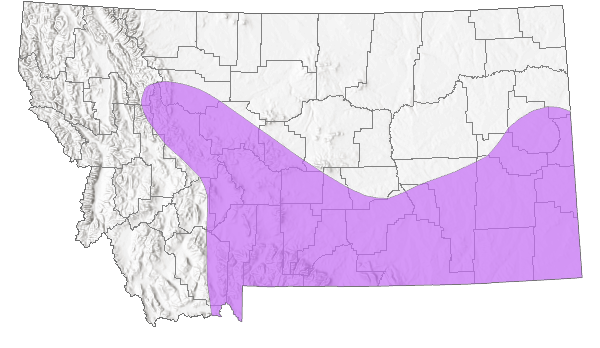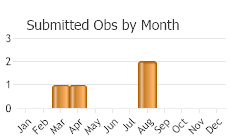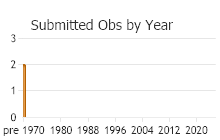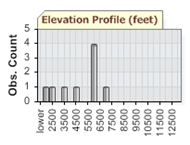View in other NatureServe Network Field Guides
NatureServe
Montana
Utah
Wyoming
Idaho
Wisconsin
British Columbia
South Carolina
Yukon
California
New York
Rocky Mountain Column - Pupilla blandii
Other Names:
Pupa blandi, Pupa sublubrica
General Description
A small shell, typically to 1.5 mm diameter and 3.4 mm in height, subcylindrical (pupiform), surface with fine incremental striae, about 6 to 7 whorls. Shell coloration is opaque pale brown. Aperture is rounded to ovate, with three teeth (denticles: parietal, columellar, lower palatal deep within the aperture), crest well developed, sinulus absent, lip sharply expanded and with a moderate to thick callus (Hendricks 2012, Burke 2013).
Diagnostic Characteristics
Pupilla are brownish shells with teeth or internal baffles, and possess an external crest behind the aperture (unlike Columella). The palatal lip is not indented, mature shells have 6-9 wholrls, the combination of which separates Pupilla from similar shaped and sized pupiform shells (Verigo). Absence of teeth in aperture distinguish Pupilla muscorum and P. hebes from P. syngenes and P. blandi. P. blandi similar to P. syngenes but mature shells with three teeth of about equal size in aperture (instead of one to three teeth all of which are relatively small), with right-curving whorls (instead of left-curving), 6-7 whorls (rather than 8-9 whorls), and shell lacking a top-heavy profile as in P. syngenes.
Species Range
Montana Range
Range Descriptions

 Native
Native
Range Comments
Native to North America; Rocky Mountains from Alberta south to Arizona and New Mexico, east as fossils or river drift to the Dakotas, Kansas, Texas. In Montana, reported east of the Continental Divide from six counties: Dawson, Gallatin, Meagher, Teton, Wheatland, Wibaux. Elevation range is 640 to 2228 m (2100 to 7310 ft). Many Montana records appear to be dead shells in river drift. Range and abundance in Montana poorly understood; current status needs investigation (Hendricks 2012).
Observations in Montana Natural Heritage Program Database
Number of Observations: 8
(Click on the following maps and charts to see full sized version)
Map Help and Descriptions
Relative Density

Recency



 (Observations spanning multiple months or years are excluded from time charts)
(Observations spanning multiple months or years are excluded from time charts)
Habitat
Not described for Montana (Hendricks 2012). Wooded sites elsewhere under aspen, cottonwood, ponderosa pine, willow. Found under woody debris or rocks, in leaf litter (Beetle 1989).
Stewardship Responsibility
References
- Literature Cited AboveLegend:
 View Online Publication
View Online Publication Beetle, D.E. 1989. Checklist of recent Mollusca of Wyoming, U.S.A. The Great Basin Naturalist 49(4):637-645.
Beetle, D.E. 1989. Checklist of recent Mollusca of Wyoming, U.S.A. The Great Basin Naturalist 49(4):637-645. Burke, T. E. 2013. Land snails and slugs of the Pacific Northwest. Corvallis, OR: Oregon State University Press. 344 p.
Burke, T. E. 2013. Land snails and slugs of the Pacific Northwest. Corvallis, OR: Oregon State University Press. 344 p. Hendricks, P. 2012. A Guide to the Land Snails and Slugs of Montana. A report to the U.S. Forest Service - Region 1. Montana Natural Heritage Program, Helena, MT. vii + 187 pp. plus appendices.
Hendricks, P. 2012. A Guide to the Land Snails and Slugs of Montana. A report to the U.S. Forest Service - Region 1. Montana Natural Heritage Program, Helena, MT. vii + 187 pp. plus appendices.
- Additional ReferencesLegend:
 View Online Publication
View Online Publication
Do you know of a citation we're missing? Berry, S.S. 1916. Notes of Mollusca of central Montana. Nautilus 29:124-128.
Berry, S.S. 1916. Notes of Mollusca of central Montana. Nautilus 29:124-128. Nekola, J.C. and B.F. Coles. 2010. Pupillid land snails of eastern North America. American Malacological Bulletin, 28(2):29-57
Nekola, J.C. and B.F. Coles. 2010. Pupillid land snails of eastern North America. American Malacological Bulletin, 28(2):29-57 Pilsbry, H.A. 1948. Land Mollusca of North America (north of Mexico), Volume II Part 2. The Academy of Natural Sciences of Philadelphia Monograph Number 2(2): 521-1113.
Pilsbry, H.A. 1948. Land Mollusca of North America (north of Mexico), Volume II Part 2. The Academy of Natural Sciences of Philadelphia Monograph Number 2(2): 521-1113. Squyer, H. 1894. List of shells from the vicinity of Mingusville, Montana. The Nautilus 8:63-65.
Squyer, H. 1894. List of shells from the vicinity of Mingusville, Montana. The Nautilus 8:63-65.
- Web Search Engines for Articles on "Rocky Mountain Column"
- Additional Sources of Information Related to "Snails / Slugs"





